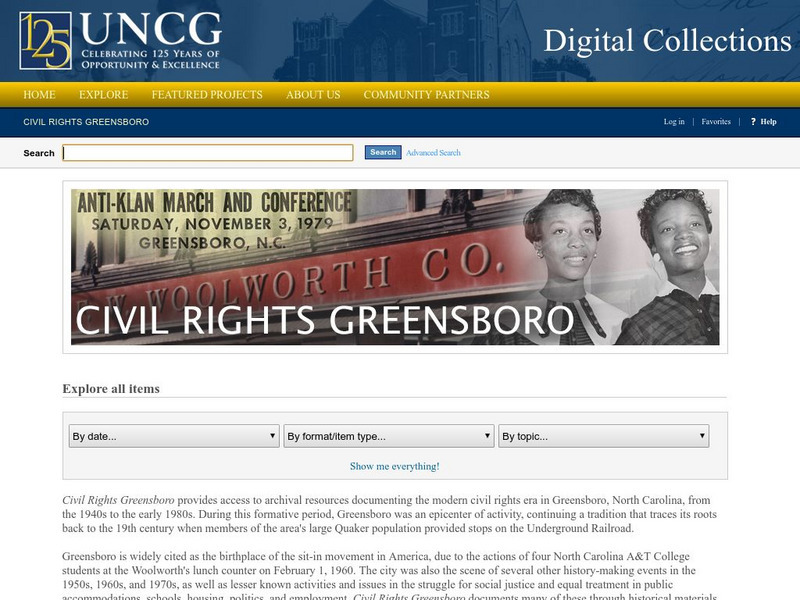Hi, what do you want to do?
PBS
Pbs Learning Media: Activism in the Civil Rights Movement
In this interactive lesson, students will learn about the historical background of racial segregation and the brave individuals and groups who stood up against segregation during the 1950s and 1960s.
Other
Civil Rights Greensboro: Greensboro Sit Ins at Woolworth's
A very detailed description of the sit-ins at the Greensboro, North Carolina, Woolworth's store and other businesses in that city during the first part of 1960. These sit-ins were to call attention to the segregation of public businesses...
CK-12 Foundation
Ck 12: Episd: Mendel's First Set of Experiments
[Free Registration/Login may be required to access all resource tools.] Understand the fundamentals of Gregor Mendel's early genetics experiments. Students will explore the Law of Segregation within genetics and how to cross F1 and F2...
Google Cultural Institute
Google Cultural Institute: Apartheid Signs
Photographic exhibition tells the story of segregation in South Africa during the last half of the 20th century.
PBS
Pbs Learning Media: Documenting Brown: Gong Lum v Rice
The Supreme Court's 1927 opinion in Gong Lum v. Rice affirmed legalized school segregation.
PBS
Pbs Learning Media: American Masters Collection: Sammy Davis Jr.
This is a collection of three video lessons about Sammy Davis Jr., comedy, race, segregation in 1960's Hollywood, politics, identity, and The Civil Rights Movement.
Tennessee History For Kids
Tennessee History for Kids: Segregation No More
This website provides information about Tennessee's role in the Civil Rights Movement.
PBS
Pbs Learning Media: Taking a Stand
This teacher lesson has the students explore discrimination and segregation and its impact on the Civil Rights movement. It begins by having the children look at rules and laws in society and then examine historical examples of...
National Humanities Center
National Humanities Center: Toolbox Library: The Making of African American Identity 1917 1968
Eighty-two primary sources explore African American identity in the 20th century. They examine segregation, migrations, protest, community, and what remained to be overcome.
Michigan State University
Michigan State University: Letter From Birmingham Jail, Martin Luther King, Jr.
This site will let you hear from Dr. Martin Luther King, Jr., in his own words in a letter written from a Birmingham jail cell in April of 1963. In this letter, Dr. King defends himself against accusations that he is an "outsider" and...
Duke University
Conscience of a Nation: John Hope Franklin on African American History
An exhibition on African-American history that is inspired by the work of John Hope Franklin (1915-2009), an African-American scholar who studied the historical roots of racial prejudice. The exhibit presents primary documents, texts,...
Emory University
Emory University: Invisible Legacy
An article discussing how George Wallace will be remembered in history because of his changing views from a "pro-segregation" racist to a backer of civil rights.
OpenStax
Open Stax: 1945 1960: African American Struggle for Civil Rights
Examines how Presidents Truman and Eisenhower dealt with the civil rights movement, the steps taken by African Americans to combat discrimination and segregation, and the reaction of white people in the South to the civil rights...
PBS
Pbs: American Experience: Freedom Riders
PBS collects and summarizes the stories of the freedom riders, who, in 1961, challenged segregation in the American South. Includes video clips from the documentary, interactive timeline of key locations and events, biographical...
Library of Congress
Loc: African American Perspectives
Library of Congress collection of books, pamphlets, and photographs that are tied together for a special presentation "The Progress of a People." Proceed through the three sessions: Segregation and Violence, Solving the Race Problem, and...
Library of Congress
Loc: Drawing the Color Line, 1860s 1890s
The Library of Congress offers a timeline of the history of baseball from the 1860s through the 1890s. See how teams were developed and trace the eventual segregation of African-Americans to all black teams by the end of the 19th century.
John F. Kennedy Presidential Library & Museum
Jfk Presidential Library & Museum: James Farmer
Letters and telegrams from the co-founder of the Congress of Racial Equality (CORE), James farmer, help tell the story of his fight against segregation during the Kennedy years.
Other
Vi Hart and Nicky Case: Parable of the Polygons
Take part in this segregation simulation that shows how small biases can lead to large collective biases. Do not fear - there is a happy ending to this simulation! You will see how a small demand for diversity can desegregate a...
Digital History
Digital History: To the Heart of Dixie
In the early 1960s civil rights activists put the ban on segregation to the test. In 1961, "Freedom riders," boarded buses headed south to test the federal ban on segregated travel. And in 1962, the University of Mississippi was ordered...
Country Studies US
Country Studies: The Divided South
This site describes how after the Civil War, the South struggled to survive. By in large, efforts to attract industry failed and soon a strictly enforced social segregation system appeared and would last until well into the 20th century.
Texas State Library and Archives Commission
Texas State Library and Archives Commission: Forever Free: 19th Century African American Legislators: 1880s Repression
This several page article recounts the black legislators in the Texas Congress and their attempts to address many issues affecting the African Americans in the state. Read about the Ku Klux Klan, convict leases, and segregation on railroads
TES Global
Blendspace: Gatsby: Jazz, Prohibition, Flappers, Segregation, and Industry
A seventeen-part learning module with links to videos, websites, and images to use while reading F. Scott Fitzgerald's The Great Gatsby.
Siteseen
Siteseen: American Historama: Brown vs Board of Education
Comprehensive overview and detailed facts about Brown vs Board of Education, a 1954 Supreme Court case won by NAACP lawyer Thurgood Marshall against school segregation.
National Humanities Center
National Humanities Center: Toolbox Library: The Black Psyche, Making of African American Identity: V. 3
Woodcuts that explore the effects of segregation on the black psyche. Links to Elizabeth Catlett's "The Negro Woman," a series of fifteen linoleum cuts are provided, as well as a summary of their meaning.
Other popular searches
- Mendel Law of Segregation
- Segregation 1930's
- Persuasive Essay Segregation
- Racial Segregation
- School Segregation
- Lessons on Segregation
- Segregation Games
- Mendel's Law of Segregation
- Segregation for Elementary
- College Segregation
- Segregation in Baseball
- Segregation and Ruby Bridges























